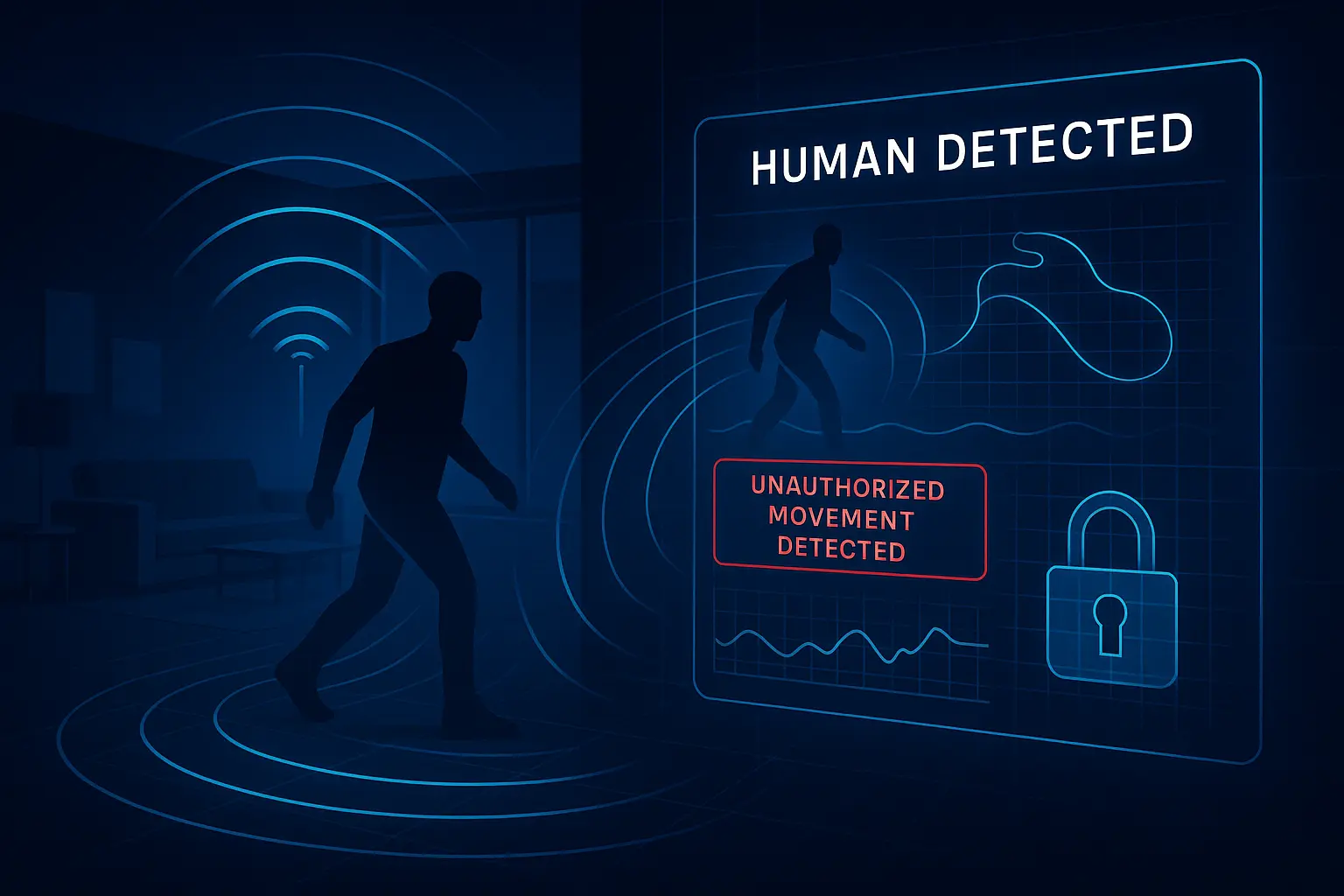Introduction
The accelerated developments in AI and Cyber Security have brought forth revolutionary means to improve home security without depending on conventional cameras or intrusive sensors. One such revolutionary development is AI-based WiFi sensing, a method that identifies human presence through examination of interruptions in WiFi signals.
This method offers a privacy-friendly, non-intrusive, and highly effective way to monitor indoor activity, making it ideal for security, elderly care, and smart home automation. However, as with any emerging technology, it also raises important questions about cyber security risks, data privacy, and ethical concerns.
In this blog, we’ll explore:
- How AI detects people using WiFi signals
- The technology behind WiFi sensing
- Benefits of this approach over traditional methods
- Potential cyber security risks and safeguards
- The Future of AI in Home Security
- How AI Utilizes WiFi to Identify Human Presence
WiFi signals, which traverse walls and objects continuously, go through tiny changes whenever people move inside their reach. AI software processes these changes to identify:
Movement and position (walking, sitting, standing in various rooms)
Breathing rhythms even perceiving small movements such as chest motions
Number of individuals within a specific area
Unlike motion sensors or cameras, WiFi sensing is line-of-sight-independent, which implies it can see people even through walls or in darkness.
The Technology Behind WiFi Sensing
WiFi waves work at particular frequencies (2.4 GHz or 5 GHz), and when these waves hit a moving body (such as a person), they reflect and distort differently. AI models analyze these distortions in the signals to conclude human presence.
Major Technologies Behind WiFi-Based Detection Ai and Cyber Security
1. Machine Learning (ML) Models
AI algorithms learn from massive datasets of patterns of WiFi signals to detect human movement. With time, the models become more accurate and less prone to false alarms due to pets or passing furniture.
2. Channel State Information (CSI)
CSI quantifies how the environment impacts WiFi signals, including:
Signal strength variation
Phase shifts due to motion
Multi-path reflections (signals reflecting off walls and humans)
Through CSI data analysis, AI is able to generate a live map of human movement in a dwelling.
3. Neural Networks for Real-Time Processing
Deep learning algorithms, specifically convolutional neural networks (CNNs) and recurrent neural networks (RNNs), analyze WiFi signal data to recognize and anticipate movement patterns. The networks are capable of separating various types of activity, including walking and falling, and thus can be applied to elderly care use cases.
Advantages of AI-Fueled WiFi Detection:
✅ No Cameras Required – Increased Privacy
Most people are not fond of cameras in their homes because it affects their privacy. WiFi sensing is a non-visual option that makes sense in bedrooms, bathrooms, and private areas.
✅ Works in Total Darkness
In contrast to infrared cameras, WiFi sensing does not depend on light, so it functions well 24/7 regardless of lighting levels.
✅ No Wearables or Physical Sensors Necessary
As opposed to some intelligent home systems that have wearable devices or use motion sensors, this approach leverages the pre-existing WiFi networks, without the need for extra hardware.
✅ Real-Time Intrusion Alerts
Whenever an intruder enters a house, AI can prompt immediate alerts to the owner’s mobile phone, providing better security.
✅ Suitable for Elderly and Child Monitoring
Families can leverage this technology to keep elderly family members or children safe through detection of falls, abnormal inactivity, or unexpected visitors.
Ai and Cyber Security Risks and Ethical Issues
Though WiFi-based human detection is cutting-edge, it also presents new cyber security risks:
1. Eavesdropping and Unauthorized Monitoring
As WiFi signals pass through walls, hackers may intercept and analyze them to spy on the occupants of a home.
Solution:
Employ strong encryption (WPA3) for WiFi networks
Implement secure authentication for AI monitoring systems
Regularly update router firmware to plug vulnerabilities
2. Data Privacy Risks
Ongoing monitoring of movement patterns prompts questions of who is privy to this information and how it’s stored.
Solution:
- Protect local processing (rather than cloud-based) to reduce data exposure
- Comply with GDPR and other privacy laws for handling data
- Provide users with opt-in or turn-off capability when needed
3. False Positives and Reliability Concerns
Pets, swaying curtains, or appliances can at times elicit false alarms.
Solution:
Train AI models using variety environmental data to enhance accuracy
Enable users to adjust sensitivity settings
The Future of AI in Home Security
As AI and Cyber Security advance further, WiFi-based detection will increasingly become more accurate and pervasive. Some possible future advancements include:
Integration with Smart Home Systems
Switching on lights automatically when someone moves around
Changing thermostat settings according to presence
Multi-Person Tracking for Greater Safety
Recognizing varying individuals based on movement patterns
Detecting emergencies (e.g., falls, intrusions) with greater accuracy
Enhanced Anti-Hacking Protections
Preventing signal interception with state-of-the-art encryption
AI-driven anomaly detection to spot cyber attacks in real time
Conclusion
AI’s ability to detect people inside a home using WiFi is a revolutionary leap in smart home security, offering a camera-free, privacy-conscious, and highly effective monitoring solution. However, as this technology grows, ensuring strong cyber security protections and ethical data usage will be crucial.
With the integration of AI-driven WiFi sensing with strong encryption and privacy controls, residents can reap the benefits of greater security without compromising on personal privacy. The future of AI and Cyber Security in home automation is bright—but responsible use will be the hallmark of success.

1 thought on “How AI Detects Persons Inside a Home Using WiFi : AI and Cyber Security”